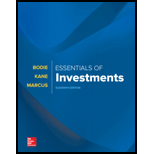
Essentials Of Investments
11th Edition
ISBN: 9781260316193
Author: Bodie
Publisher: MCG
expand_more
expand_more
format_list_bulleted
Concept explainers
Textbook Question
Chapter 5, Problem 4PS
You’ve just decided upon your capital allocation for the next year, when you realize that you’ve underestimated both the expected return and the standard deviation of your risky portfolio by a multiple of 1.05. Will you increase, decrease, or leave unchanged your allocation to risk-free T-bills? (LO 5-4)
Expert Solution & Answer
Want to see the full answer?
Check out a sample textbook solution
Students have asked these similar questions
What is the risk-return tradeoff, and why is it important in finance? need help !
What is the risk-return tradeoff, and why is it important in finance?
No chatgpt!
Can you explain the concept of net present value (NPV) and how it is used in investment decisions?
Chapter 5 Solutions
Essentials Of Investments
Ch. 5 - Prob. 1PSCh. 5 - The real interest rate approximately equals the...Ch. 5 - When estimating a Sharpe ratio, would it make...Ch. 5 - You’ve just decided upon your capital allocation...Ch. 5 - Prob. 5PSCh. 5 - The stock of Business Adventures sells for $40 a...Ch. 5 - Prob. 7PSCh. 5 - a. Suppose you forecast that the standard...Ch. 5 - Using the historical risk premiums as your guide,...Ch. 5 - What has been the historical average real rate of...
Ch. 5 - Consider a risky portfolio. The end-of-year cash...Ch. 5 - For Problems 12-16, assume that you manage a risky...Ch. 5 - For Problems 12-16, assume that you manage a risky...Ch. 5 - For Problems 12-16, assume that you manage a risky...Ch. 5 - For Problems 12-16, assume that you manage a risky...Ch. 5 - For Problems 12-16, assume that you manage a risky...Ch. 5 - Prob. 17PSCh. 5 - You manage an equity fund with an expected risk...Ch. 5 - What is the reward-to--volatility (Sharpe) ratio...Ch. 5 - A portfolio of nondividend-paying stocks earned a...Ch. 5 - Which of the following statements about the...Ch. 5 - Which of the following statements reflects the...Ch. 5 - Use the following data in answering CFA Questions...Ch. 5 - Prob. 5CPCh. 5 - Lise the following data in answerifng CFA Question...Ch. 5 - Use the following scenario analysis for stocks X...Ch. 5 - Prob. 8CPCh. 5 - Use the following scenario analysis for stocks X...Ch. 5 - 10. Probabilities for three states of the economy...Ch. 5 - 11. An analyst estimates that a stock has the...Ch. 5 - Prob. 1WMCh. 5 - Prob. 2WMCh. 5 - Prob. 3WM
Knowledge Booster
Learn more about
Need a deep-dive on the concept behind this application? Look no further. Learn more about this topic, finance and related others by exploring similar questions and additional content below.Similar questions
- Can you explain the concept of net present value (NPV) and how it is used in investment decisions?i need answerarrow_forwardCan you explain the concept of net present value (NPV) and how it is used in investment decisions? need explarrow_forwardCan you explain the concept of net present value (NPV) and how it is used in investment decisions?arrow_forward
- Mr. Siya, the Chief Financial officer at WXZY Limited has noticed an increase in the company's stock returns variation over the last two financial years. He is interested in understanding the underlying influences on the company's stock returns. You have been tasked to perform a linear regression to understand whether the company's profit margins (independent variable) impact its stock returns. You have been provided with data for both the company's average monthly stock returns and profit margins over a 6-month period in 2022. Month July August September October November December Profit margins (x) Stock returns (y) 0.0263 0.0618 0.0389 0.1156 0.0158 0.0534 0.0461 0.1610 0.0030 0.0395 0.0393 0.1031 a) Calculate both the slope coefficient of the regression. b) Calculate the intercept of the regression. c) Calculate the unexplained/unexpected variation of the regression. d) Calculate the coefficient of determination. 6000 (2) (5) (3)arrow_forwardDo not answer wit incorrect values i will unhelpful!arrow_forwardWhat are the implications of missing a credit card payment in finance?arrow_forward
arrow_back_ios
SEE MORE QUESTIONS
arrow_forward_ios
Recommended textbooks for you
 Essentials Of InvestmentsFinanceISBN:9781260013924Author:Bodie, Zvi, Kane, Alex, MARCUS, Alan J.Publisher:Mcgraw-hill Education,
Essentials Of InvestmentsFinanceISBN:9781260013924Author:Bodie, Zvi, Kane, Alex, MARCUS, Alan J.Publisher:Mcgraw-hill Education,

 Foundations Of FinanceFinanceISBN:9780134897264Author:KEOWN, Arthur J., Martin, John D., PETTY, J. WilliamPublisher:Pearson,
Foundations Of FinanceFinanceISBN:9780134897264Author:KEOWN, Arthur J., Martin, John D., PETTY, J. WilliamPublisher:Pearson, Fundamentals of Financial Management (MindTap Cou...FinanceISBN:9781337395250Author:Eugene F. Brigham, Joel F. HoustonPublisher:Cengage Learning
Fundamentals of Financial Management (MindTap Cou...FinanceISBN:9781337395250Author:Eugene F. Brigham, Joel F. HoustonPublisher:Cengage Learning Corporate Finance (The Mcgraw-hill/Irwin Series i...FinanceISBN:9780077861759Author:Stephen A. Ross Franco Modigliani Professor of Financial Economics Professor, Randolph W Westerfield Robert R. Dockson Deans Chair in Bus. Admin., Jeffrey Jaffe, Bradford D Jordan ProfessorPublisher:McGraw-Hill Education
Corporate Finance (The Mcgraw-hill/Irwin Series i...FinanceISBN:9780077861759Author:Stephen A. Ross Franco Modigliani Professor of Financial Economics Professor, Randolph W Westerfield Robert R. Dockson Deans Chair in Bus. Admin., Jeffrey Jaffe, Bradford D Jordan ProfessorPublisher:McGraw-Hill Education

Essentials Of Investments
Finance
ISBN:9781260013924
Author:Bodie, Zvi, Kane, Alex, MARCUS, Alan J.
Publisher:Mcgraw-hill Education,



Foundations Of Finance
Finance
ISBN:9780134897264
Author:KEOWN, Arthur J., Martin, John D., PETTY, J. William
Publisher:Pearson,

Fundamentals of Financial Management (MindTap Cou...
Finance
ISBN:9781337395250
Author:Eugene F. Brigham, Joel F. Houston
Publisher:Cengage Learning

Corporate Finance (The Mcgraw-hill/Irwin Series i...
Finance
ISBN:9780077861759
Author:Stephen A. Ross Franco Modigliani Professor of Financial Economics Professor, Randolph W Westerfield Robert R. Dockson Deans Chair in Bus. Admin., Jeffrey Jaffe, Bradford D Jordan Professor
Publisher:McGraw-Hill Education
The U.S. Treasury Markets Explained | Office Hours with Gary Gensler; Author: U.S. Securities and Exchange Commission;https://www.youtube.com/watch?v=uKXZSzY2ZbA;License: Standard Youtube License